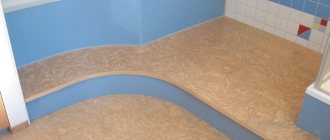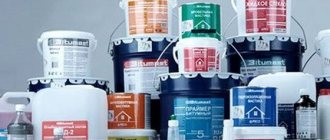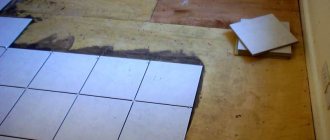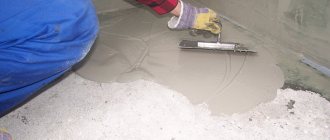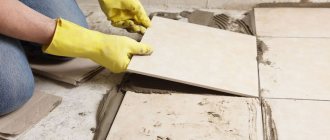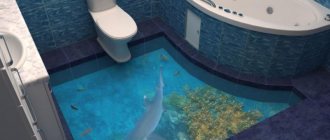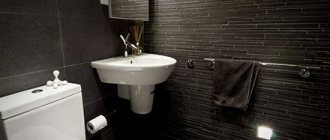04.03.2020
0
2 068
Plumbing
An effective waterproof barrier between the tiles in the bathroom and the material underneath in a wooden house is of particular importance.
Gravity ensures that water always moves vertically down the shortest route. This means that if the waterproofing of a bathroom in a wooden house is made with gaps, water will seep in and destroy the underlying structures.
Quite an impressive video as a visual example.
But even here there was a mistake: the color of the mastic is so that it is clearly visible that it has dried: it darkens by 2-3 tones.
The second danger of not working waterproofing is that drops of water may appear on electrical appliances in the basement or on the first floor of a wooden house. A short circuit or electric shock is likely.
The mere fact of constructing a waterproof layer does not indicate that it will work.
Here are the typical factors that cause bathroom waterproofing systems to fail.
- During application, the surface was poorly prepared and the primer was applied formally.
- The curing times for floor screeds and coatings were not observed.
- Poor drainage has led to stagnation of water, which will eventually penetrate into the ceiling.
- Low-quality, incompatible materials were used.
It only takes one mistake in the design or an oversight by the builders to create a leak, which can lead to costly rework.
On the other hand, the cost of waterproofing should be reasonable. It is best to have a project, and for self-builders to use a freely available standard one as a basis.
Wooden structures require special protection from water, which we will look into.
- 1 Principles of water protection design
- 2 Waterproofing a wooden floor in a bathroom
- 3 Waterproofing wooden walls in the bathroom
- 4 Materials
- 5 Conclusion 5.1 Related Articles
What waterproofing materials are there?
The construction market offers a wide range of waterproofing materials. All products can be divided into several groups if classified according to the method of applying waterproofing.
Group #1: painting
This group includes all types of mastics and emulsions produced on a polymer or bitumen basis. After applying these compounds, a stable waterproof surface is created.
Painted waterproofing must be applied in layers, maintaining a certain time interval between approaches.
Group #2: stick-on
This group contains roll or film materials made on a bitumen or polymer base. Gluing materials onto a wooden surface is done using hot or cold mastic applied in several layers.
One of the significant disadvantages of using adhesive waterproofing is the presence of seams between the sheets, into which moisture can penetrate.
The problem is solved by laying the sheets overlapping, as well as pouring rolled waterproofing with waterproof cement-based compounds, such as hot bitumen or pitch.
Before applying heated bitumen, sheet or roll waterproofing is covered with reinforced fiberglass.
After the applied composition hardens, a seamless layer is formed over the entire surface, which meets all technological requirements for waterproofing.
Group #3: impregnating
This group includes all impregnating materials that contain water-repellent cement with the addition of crushed sand and chemicals.
When applying such waterproofing, the surface of the wood is impregnated and made waterproof. This type of waterproofing is not recommended for residential premises.
Of the listed groups, only the first two are suitable for waterproofing a bathroom in a wooden house.
They are often combined, using mastics for waterproofing hard-to-reach places, and rolled materials for smooth surfaces.
The wooden walls of the bathroom in the house are impregnated with a moisture-resistant composition, and a waterproofing layer is provided under the tiled floors
How to apply waterproofing material correctly?
Before applying waterproofing, the surface is cleaned and primed with deeply penetrating compounds. After the primer has dried, a layer of bitumen mastic is poured in, with special attention paid to sealing the cracks present in the places where communications are laid and coating the corners.
Remember, while the mastic is drying, you cannot dust it. A day after the bitumen mastic has dried, the next layer of waterproofing is laid in the form of canvases cut to the size of the bathroom.
Their number is calculated taking into account the fact that they will overlap each other, overlapping each other by 10-15 cm.
It is recommended to make the floor in the bathroom lower than in the rest of the house. A small headroom will save you from flooding the entire house in the event of a sudden emergency such as a pipe break or a leak in a connection, a washing machine breakdown or other incidents.
Waterproofing your floor will prevent water from seeping into your basement or lower level of your home. The water will stand until its level rises above the remaining supply.
Particular attention is paid to the so-called “wet” zone, which includes, in addition to the floor, walls near the bathroom, shower stall, and around the washbasin within a radius of 50 cm.
The ceiling in the bathroom is made suspended from moisture-resistant plasterboard or glossy PVC panels. Wooden structures, camouflaged behind the finishing, are primed and coated with mastics.
Scheme of required places for applying waterproofing in a bathroom in a wooden house, taking into account the minimum distances around plumbing fixtures
Warm floor
The installation of heated floors is very popular among owners of private houses, including wooden ones. Installing a water heated floor requires pouring a screed, while electric infrared floors are mounted on a wooden base.
There is a laying technology for water heated floors, when the base is covered with polystyrene laying mats, inside which pipes are laid. A gypsum board coating is placed on top as a base for the final coating.
Layered method
Table 2. Method of installing heated floors without pouring screed
| Illustration | Description |
| The surface of the subfloor is covered with foamed polyethylene with a reflective film based on lavsan. | |
| The bars are installed, between which the pipes will be located. | |
| The distance between the bars should be exactly 20 mm. To control, you can place the plate so that it fits snugly against the bars. | |
| The bars are fixed using wood screws, recessing the caps by 2 mm. It is recommended to fasten the bars in increments of 30 cm. | |
| After all the bars are secured, heat distribution plates are inserted. Each plate is supplied in a length of 120 cm and is divided into 20 cm sections. The plates must be laid depending on the pipe laying spacing from 20 to 30 cm between pipes. | |
| Plates are not used at pipe turning points. | |
| Starting from the installation box installed in the corner of the room, the pipe is laid in the recess in the heat distribution plates. | |
| When turning the pipes, take a larger radius so as not to damage the polyethylene. | |
| The next step is to lay gypsum fiber sheets, which will promote uniform heating of the floor and create additional heat accumulation. | |
| The sheets are fixed to the block with self-tapping screws, being careful not to damage the pipe. | |
| At the final stage, the finishing coating is laid - laminate, linoleum or tile. |
The heated floor system not only increases the comfort of staying in the room, but also allows you to disguise communications.
Details about waterproofing a wooden floor
In wooden houses, as a rule, the floors are also made of wood. Concrete screeds are not welcome, as they increase the load on the foundation of the house and act as cold bridges through which heat flows out of the living space.
Therefore, in a wooden house, floors are laid on joists, which are thoroughly impregnated with waterproofing materials.
Before starting to process the logs, waterproof the foundation by coating it with mastic or plastering it with a special solution obtained from a mixture containing polymer additives.
A subfloor is laid on antiseptic-impregnated logs, which is covered with rolled waterproofing. Floor tiles are laid on top of this material.
Technology for laying roll waterproofing on the floor
One of the main factors influencing the choice of materials in modern construction and renovation is the speed of their installation. This can be achieved through:
- reducing interlayer laying intervals;
- reduction of intervals for performing related technological processes.
Self-adhesive bitumen-polymer film used for waterproofing the floor in the bathroom of a wooden house is one of these materials.
This option is also suitable for waterproofing interfloor ceilings, bathrooms, rooms with wet technological processes, and kitchens.
The film adheres perfectly not only to concrete bases, but also to wooden ones. Therefore, this roll material can be used for waterproofing horizontal and vertical surfaces in a wooden house.
The entire process from preparing the floor to applying ceramic tiles to it is carried out without interruption, that is, in one cycle. Waterproofing a bathroom floor can be done using this technology in one day.
Particular attention must be paid to preparing the base, since the quality of installation of the waterproofing membrane depends on this stage.
Schematic illustration of the installation of moisture-resistant floor and wall surfaces in a bathroom located in a wooden private house, cottage or townhouse
Work execution algorithm
- First, sweep or vacuum all dust and dirt from the subfloor to ensure good adhesion of the waterproofing film to the wood base.
- The next step is priming the floor, during which a bitumen emulsion primer is applied to the entire surface with a roller, which does not have an unpleasant odor, since it is diluted with ordinary water and not a solvent. The primer is also applied to the walls around the perimeter of the bathroom, with a strip width of 20 cm. In corners and places difficult to reach with a roller, the primer is applied with a brush.
- Check the degree of drying of the applied primer using a cotton pad, which is applied to the treated floor. If the cotton pad remains clean, the bitumen primer has dried. Please note that the entire drying process at a room temperature of 20 degrees will take no more than 20 minutes.
- After the primer has dried, they immediately begin laying the waterproofing membrane, which can be used as a self-adhesive bitumen-polymer roll material. Its installation does not require the use of open fire, which is very important for wooden buildings. The material can be easily installed on your own; in exceptional cases, you can get by with the help of your wife or mother-in-law.
- When rolling out the roll, measure out a piece of the required length and cut it off with a sharp stationery knife, allowing the material to rest for a while. Then they twist the fabric from both ends to the center, cut the protective film, carefully remove it, unwinding the roll in the opposite direction, while the material is firmly glued to the base.
- Air bubbles are removed with a brush, which is used to iron the laid fabric several times.
- The next sheet is laid with an overlap, the width of which should be at least 100 mm. The overlap area is treated with a primer or bitumen mastic. Roll thoroughly with a heavy roller.
- After applying the roll waterproofing to the horizontal surface of the floor, they begin to treat the walls adjacent to the floor. To do this, canvases 30-35 cm wide are cut, of which 10 cm goes on the floor, and the rest on the wall. An incision in the film is made at a distance of 10 cm from the edge. First, the waterproofing material is glued to a vertical surface, that is, to the wall, and then placed on the floor, previously lubricated with primer.
- After completing the installation of self-adhesive roll waterproofing, they immediately begin laying ceramic tiles on the floor.
Preparatory work
Before installing waterproofing, the following operations are performed:
- the floor is cleared of debris;
- inspected for damage. Detected cracks, crevices and other defects are repaired with wood mastic;
- remove debris again and then treat the floor with bio- and fire-retardant impregnations;
- coat the floor and walls to a height of 20-25 cm with primer. It improves adhesion and prevents waterproofing mastic from being absorbed into the wood. Use the composition recommended by the manufacturer of the waterproofing material. Often a solvent-free bitumen emulsion primer is used (diluted with water);
- continue work after the primer has dried, which should be verified by applying a cotton pad. The latter must remain clean;
- After the primer has dried, seal corners, seams between boards and other places where moisture can seep in with self-adhesive waterproofing tape. The areas where utility lines pass are sealed with rubber liners and also covered with tape.
According to the requirements of SNiP, the surface of the finished floor in the bathroom should be several centimeters lower than the floor in the adjacent room, and a threshold should be installed at the entrance.
Coating waterproofing: the optimal solution
To protect the surfaces of the floor and walls in the bathroom of a wooden house, water-repellent coating materials produced in the form of various mastics are ideal:
- Polymer-bitumen mastics are easy to apply and durable in use.
- Polymer-cement mastics are capable of forming a strong layer of waterproofing film, one of the properties of which is a good degree of bending resistance.
- Bituminous mastics are among the cheapest coating waterproofing materials with reduced quality, since they become brittle at subzero temperatures.
- Bitumen-rubber mastic compositions have higher plasticity, and therefore are able to withstand those low temperatures at which conventional bitumen mastics begin to collapse. Naturally, bitumen-rubber mastic is sold at a higher price.
Another scheme for installing waterproofing in a room with a high level of humidity, which includes a bathroom in a wooden house
Polymer-cement mastic consists of a powder containing moisture-proof binders and inert fillers. It also contains water-dispersed acrylic polymers.
After mixing all the components, a waterproofing material is obtained that has a high ability of adhesion (adhesion) to any type of base.
Tip #1:
If you additionally lay a reinforced fiberglass mesh between the layers of polymer-cement mastic, the waterproofing will be even stronger and more reliable.
Tip #2:
Seams connecting vertical surfaces to horizontal planes must be reinforced with elastic sealing tape.
Preparing a wooden floor for waterproofing
Before applying coating waterproofing to the surface of a rough wooden floor, a number of preparatory measures are required to seal the cracks.
This will reduce the consumption of mastic, which will not seep through cracks, chips and crevices in the floor.
The subfloor must be cleaned of dirt, a sheathing of bars must be laid on it, and insulation must be inserted into the cells, for which it is better to use polystyrene foam, which forms a hard and even surface after installation.
The joints between polystyrene foam boards and joists should be treated with sealant. Instead of polystyrene foam, you can lay mineral mats, but they will have to be covered with waterproof plywood.
Preparing a wooden subfloor in the bathroom of a private house for application of the selected waterproofing material
↑ Types of wood for bathroom floors
The reliability and effectiveness of floor waterproofing depends to some extent on the quality characteristics of the type of wood used. The most important property is good moisture resistance.
There are several types of wood that are most suitable for flooring:
- Larch is the best option; it is quite resistant to moisture.
- Cork flooring is one of the acceptable options; it is resistant to moisture and has high strength. This flooring has good decorative properties and is almost non-slip.
- Teak is an expensive solution for the bathroom; it is not afraid of moisture, as it contains a high concentration of essential oils. It is characterized by a long service life provided that the cracks between the boards are carefully filled with sealant.
- Thermowood is a popular new material that is wood that has been steam-treated at high temperatures (over 220 degrees) in an oxygen-free environment. Thanks to this treatment, thermowood acquires increased resistance to fungi, as well as reduced water absorption.
Naturally, when interacting with water or moisture, the wood will begin to swell and rot. Therefore, the issue of reliability of waterproofing of a wooden floor should be given great attention at all stages of the work.
Technology for applying coating waterproofing
- Mix liquid rubber with the activator, and immediately apply the resulting composition to the floor using a roller. Using a brush, carefully coat the joints of the floor and walls.
- Wait until the liquid rubber has completely dried, then evaluate the quality of the resulting waterproofing. The surface of the film should be uniform and smooth to the touch. You can apply an additional second layer of waterproofing so that the final thickness of the protective film is about 2 mm.
Laying the finishing floor covering in the form of tiles directly on the waterproofing layer is not carried out, since tile adhesive does not adhere well to rubber compounds.
This drawback is corrected by pouring a thin concrete screed reinforced with reinforcing mesh.
Coating-type waterproofing applied to floors, adjacent walls, bathroom screens, areas near pipes of water supply and sewerage systems
Coating waterproofing is used to protect wooden and concrete surfaces. This method is suitable not only for finishing bathrooms, but also for renovating rooms with even higher levels of humidity.
Such objects include swimming pools, water parks, washing departments of bathhouses, etc. The undoubted advantage of coating technology is the ease of installation of waterproofing, which is very important when decorating a bathroom in a wooden house with your own hands.
Mastics, which are fluid masses, are simply applied to the surface, leveled and dried for the time required for this process.
Once dry, the waterproofing film acquires excellent water-repellent properties and becomes capable of stretching and subsequently restoring its original shape.
That is why coating waterproofing is considered the optimal solution for protecting a wooden floor in a bathroom.
Recommendations for choosing wood
Despite the tendency to be damaged by microorganisms, natural wood is characterized by a number of attractive properties for any owner:
- Excellent appearance;
- Warm, cozy atmosphere;
- Natural purity of wooden material.
Wood is a very environmentally friendly material that can bring a touch of comfort to any interior.
Therefore, the only question is to choose the right type of wood. To furnish a bathroom you need moisture-resistant wood. The best options here are:
- Teak. Teak wood is widely known for its unique characteristics. It has a beautiful grainy texture and is completely moisture resistant. If the longitudinal conductors at the joints are treated with sealant, then even ceramic tiles will be envious of their resistance to moisture. The only disadvantage of this breed is its high cost. For the tree grows in South Asian latitudes.
- Larch. This domestic breed is practically not inferior to the previous version, since the high resin content prevents the penetration of moisture. Perhaps it is somewhat less beautiful, but this is compensated by a more adequate cost.
- Thermowood. By treating the wood with steam, it is possible to obtain a moisture-resistant and attractive coating. It is necessary to specifically choose an option designed for the bathroom, since it will already come complete with structural elements.
